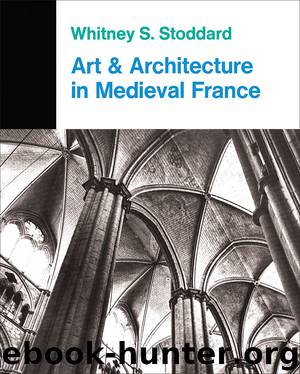Art and Architecture in Medieval France: Medieval Architecture, Sculpture, Stained Glass, Manuscripts, The Art of the Church Treasuries by Whitney S. Stoddard

Author:Whitney S. Stoddard
Language: eng
Format: epub
Publisher: Routledge
Published: 2018-09-20T16:00:00+00:00
Fig. 260 Amiens Cathedral. Cross section (after Durand)
Fig. 261 Amiens Cathedral. Crossing, transept, nave
Fig. 262 Amiens Cathedral, begun 1220. Nave from
Fig. 263 Amiens Cathedral. Plan (after Durand) south aisle
Robert de Luzarches, the Amiens architect, either transformed the Chartres format directly or knew the Chartres design as it had been interpreted in later monuments. By comparing details of Chartres (1194), Soissons (late 1190’s), and Reims (1211) with Amiens (1220), the subtle changes in form can be studied (figs. 224, 236, 249, 262). The Amiens master rejected the horizontal floral friezelike capital of Reims and returned to the Chartres capital and the organization of the arch of the Chartres nave arcade. However, he changed the nature of the capital above the colonnette on the nave side. By eliminating the elaborate base from which the bundle of five colonnettes rise, as at Chartres, the Amiens master was able to achieve greater visual continuity between nave pier and the rising colonnettes. Only a simple curved abacus separates the engaged shaft of the nave pier from the major colonnette above. The ornaments on the Amiens capitals are more three-dimensional in their projections than the Chartres capitals. Above the abacus of the Amiens piers the master builder reduced the number of colonnettes from five, as it appeared in Chartres and Reims, to three and eliminated the alternation which can be seen in the larger respond or colonnette at Chartres. This reduction from five to three responds between the spandrels of the nave arcade suggests a greater thinness of the structure in comparison to the more massive quality of both Chartres and Reims.
To accent the separation between the nave arcade and triforium levels, the Amiens builder has converted the simple torus molding of the stringcourse of Chartres and Reims into a larger, floral molding. It is possible that he wished to transfer the horizontal continuity achieved by the floral capitals in the nave of Reims and place that horizontal accent on the molding at the base of the triforium.
The triforium in each of the bays in the naves of Chartres and Reims consists of an arcade of four apertures. At Amiens, however, the architect divided the triforium into two arches encompassing, in turn, three smaller arches (fig. 262). Over the three arches is a trefoil. This division of the triforium into an arcade, with relieving arches surrounding it, is not a new invention of the Amiens master, but a rethinking of Early Gothic design such as the false triforium of the Cathedral of Sens (figs. 139, 144). The wall rib or formeret does not begin at the nave arcade capitals, as in Chartres, Soissons, and Reims, but starts from its own plinth at the base of the triforium. This change accounts for the reduction at Amiens from five colonnettes to three above in the zone of the nave arcade. By starting the wall rib at the base of the triforium, the architect pushes the outside wall of the triforium back from the spandrels of the arch of the nave arcade.
Download
This site does not store any files on its server. We only index and link to content provided by other sites. Please contact the content providers to delete copyright contents if any and email us, we'll remove relevant links or contents immediately.
| Body Art & Tattoo | Calligraphy |
| Ceramics | Conceptual |
| Digital | Erotic |
| Film & Video | Glass |
| Graffiti & Street Art | Illuminations |
| Installations | Mixed Media |
| Mosaic | Prints |
| Public Art | Video Games |
Kathy Andrews Collection by Kathy Andrews(10554)
Thirteen Reasons Why by Jay Asher(7803)
The Red Files by Lee Winter(2923)
How to Do Nothing by Jenny Odell(2651)
The Genius of Japanese Carpentry by Azby Brown(2616)
Stacked Decks by The Rotenberg Collection(2283)
Tattoo Art by Doralba Picerno(2087)
Champions of Illusion by Susana Martinez-Conde & Stephen Macknik(2080)
The Art of Doom by Bethesda(1777)
The Artist's Way Workbook by Cameron Julia(1736)
Calligraphy For Dummies by Jim Bennett(1645)
Creative Character Design by Bryan Tillman(1563)
Botanical Line Drawing by Peggy Dean(1534)
One Drawing A Day by Veronica Lawlor(1497)
Wall and Piece by Banksy(1463)
The Art of Creative Watercolor by Danielle Donaldson(1455)
Art Of Atari by Tim Lapetino(1329)
Happy Hand Lettering by Jen Wagner(1325)
Artificial Intelligence for Games by Ian Millington & John Funge(1305)
